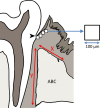Effects of theaflavins on tissue inflammation and bone resorption on experimental periodontitis in rats
- PMID: 30159985
- PMCID: PMC6221153
- DOI: 10.1111/jre.12600
Effects of theaflavins on tissue inflammation and bone resorption on experimental periodontitis in rats
Abstract
Background and objective: Theaflavins (TFs), the major polyphenol in black tea, have the ability to reduce inflammation and bone resorption. The aim of this study was to evaluate the effects of TFs on experimental periodontitis in rats.
Material and methods: Thirty rats were divided into five groups: Control (glycerol application without ligation), Ligature (glycerol application with ligation), TF1 (1 mg/mL TF application with ligation), TF10 (10 mg/mL TF application with ligation), and TF100 (100 mg/mL TF application with ligation). To induce experimental periodontitis, ligatures were placed around maxillary first molars bilaterally. After ligature placement, 100 μL glycerol or TFs were topically applied to the rats daily, and rats were euthanized 7 days after ligature placement. Micro-computed tomography was used to measure bone resorption in the left side of the maxilla, and quantitative polymerase chain reaction was used to measure the expression of interleukin (IL)-6, growth-regulated gene product/cytokine-induced neutrophil chemoattractant (Gro/Cinc-1, rat equivalent of IL-8), matrix metalloproteinase-9 (Mmp-9), receptor activator of nuclear factor-kappa Β ligand (Rankl), osteoprotegerin (Opg), and the Rankl/Opg ratio in gingival tissue. With tissue from the right side of the maxilla, hematoxylin and eosin staining was used for histological analysis, immunohistochemical staining for leukocyte common antigen (CD45) was used to assess inflammation, and tartrate-resistant acid phosphatase (TRAP) staining was used to observe the number of osteoclasts.
Results: The TF10 and TF100 groups, but not the TF1 group, had significant inhibition of alveolar bone loss, reduction in inflammatory cell infiltration in the periodontium, and significantly reduced numbers of CD45-positive cells and TRAP-positive osteoclasts compared with the Ligature group. Correspondingly, the TF10 and TF100 groups had significantly downregulated gene expression of IL-6, Gro/Cinc-1(IL-8), Mmp-9, and Rankl, but not of Opg. Consequently, Rankl/Opg expression was significantly increased in the Ligation group but was attenuated in the TF10 and TF100 groups.
Conclusion: The results of this study suggest that topical application of TFs may reduce inflammation and bone resorption in experimental periodontitis. Therefore, TFs have therapeutic potential in the treatment of periodontal disease.
Keywords: cytokines; experimental periodontitis; periodontal disease; theaflavin.
© 2018 The Authors. Journal of Periodontal Research Published by John Wiley & Sons Ltd.
Figures








References
-
- Williams RC. Periodontal disease. N Engl J Med. 1990;322:373‐382. - PubMed
-
- Dongari‐Bagtzoglou AI, Ebersole JL. Increased presence of interleukin‐6 (IL‐6) and IL‐8 secreting fibroblast subpopulations in adult periodontitis. J Periodontol. 1998;69:899‐910. - PubMed
-
- de Oliveira PA, de Pizzol‐Junior JP, Longhini R, Sasso‐Cerri E, Cerri PS. Cimetidine reduces interleukin‐6, matrix metalloproteinases‐1 and ‐9 immunoexpression in the gingival mucosa of rat molars with induced periodontal disease. J Periodontol. 2017;88:100‐111. - PubMed
-
- Chakrabarti S, Patel KD. Regulation of matrix metalloproteinase‐9 release from IL‐8‐stimulated human neutrophils. J Leukoc Biol. 2005;78:279‐288. - PubMed
MeSH terms
Substances
Grants and funding
LinkOut - more resources
Full Text Sources
Other Literature Sources
Medical
Research Materials
Miscellaneous

